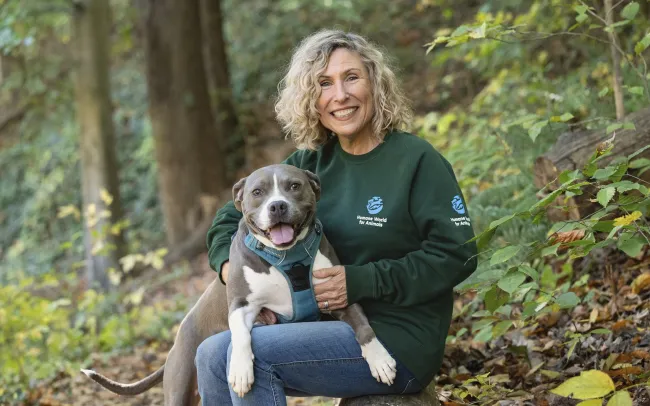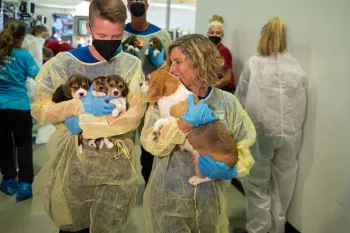Note: This blog is part of a series highlighting how we tackle the root causes of animal cruelty to create permanent change. This post focuses on our direct care, rescue and sanctuary work. Previous posts have covered how we’re ending the worst forms of institutionalized animal suffering through our efforts with corporations and governments.
I still remember the moment, years ago, when I entered a house in Muncie, Indiana—where local police had enlisted our help to rescue the animals inside—the stench of ammonia hit me immediately. In all my years of this work, I hadn’t seen animals living in conditions like this before. As our Animal Rescue Team moved through the house, we had to be careful not to slip on the layers of built-up filth, and we saw that many of the cats peering out at us were very thin, sick or suffering from injuries. All of them were struggling to keep themselves clean, despite the conditions there.
It never ceases to amaze me how resilient and forgiving animals are. This is something that I know keeps me—and our team—going even through the most painful of cases. Despite everything these cats suffered, many of them came right up to us to purr and seek head scratches. Some of the cats even followed us around the house.
That day, I witnessed just a small portion of the Animal Rescue Team’s work. There’s so much more to it. Before team members respond to alleged cruelty cases, hurricanes and other disasters, puppy mill rescues and other situations, they need to coordinate with local officials and plan the logistics of how to most efficiently remove ailing and traumatized animals from the scene while causing as little stress as possible. They also need to prepare the necessary equipment, identify facilities for temporary shelter if needed, find housing for responders and more. Once on site, the team must maneuver through scenes of devastation and disrepair.
During the Muncie rescue, the team—clad in protective gear—navigated surfaces caked in filth while being hit with the overwhelming smell of urine and feces. That’s just one example of the kind of challenges they face in the field; there are so many others. When responding to disasters, for example, areas may be flooded, filled with rubble or without access to power. Sometimes the team is called to rescue wild animals who need specialized handling and care. In 2019, the team rescued over 200 wild animals, including tigers, kangaroos and a camel, from a Canadian roadside zoo (read more about the behind-the-scenes work of the Animal Rescue Team).
After we rescue the animals, they may go to temporary shelters, where their medical needs are assessed and treated, and evidence for potential prosecutions is gathered. Some of those we rescue have long roads to recovery: Malnutrition and skin and respiratory conditions are common for animals living in cruel conditions like the ones seen in puppy mills and roadside zoos and on dog meat farms. Many rescued animals will go to our Maryland care and rehabilitation center. This large facility allows us to hold animals for an extended period, where our veterinary experts can give them essential care and the time they need to heal and build their trust in people. We’ve seen dogs whose spirits seemed broken after living their whole lives in the wire cages of dog meat farms in South Korea, regain the spring in their step and the spark in their eyes.
Once the animals have a clean bill of health, they can be transported to their next destination: For companion animals, this is often one of our shelter and rescue partners, where they will find adoptive homes; for farm and wild animals, this can be a sanctuary, such as our own Black Beauty Ranch in Texas, a 1,400-acre facility where the animals will live out their lives.
Black Beauty Ranch is home to nearly 600 animals—of over 40 species—from goats, pigs and bison to tigers, bears and monkeys, all rescued from cruelty and neglect cases, the exotic pet trade, roadside zoos, research laboratories and other situations. Even after animals are rescued, a lot of work still goes into their rehabilitation and care. Not only do they need proper diets and habitats, but they require routine veterinary care and natural enrichment activities to ensure they are stimulated and their species-specific needs are met. Most profoundly, given where they come from, they have people who are finally thinking of their interests and wellbeing above all else. For example, there are four tigers at Black Beauty; two were rescued from the exotic pet trade and can thrive best in their own separate habitats, where they don’t have to feel territorial. But the other two, Serenity and Theodora, were rescued from a shuttered Canadian roadside zoo where they had bonded. Now they share one habitat at Black Beauty.

Randi Salisbury/The HSUS
We also run another special sanctuary in Liberia: Second Chance Chimpanzee Refuge. A decade ago, dozens of chimps already traumatized by their use as laboratory test subjects found themselves abandoned on a set of islands in Liberia, after funding for their care was pulled. Even though the chimps’ caretakers no longer had jobs or support, they stayed and fed the animals as best they could to make sure the animals didn’t die. We stepped in to help them, and now Humane World for Animals Liberia is responsible for their lifelong care at the refuge.
Not all our direct care work involves rescuing animals. Staff members working in our Pets for Life and Rural Area Veterinary Services programs spend much of their time with people. These programs increase equity in access to care by providing people what they want and need for their pets. We offer spay/neuter surgeries, basic veterinary care, pet food and supplies and ongoing resources at no cost directly to residents in the most underserved communities of Los Angeles and Philadelphia. Through our mentorship program, we work with governments and organizations across the country to help them implement their own Pets for Life programs, which, in turn, keeps people and pets together despite financial hardships. (More on this in our next post in this series on partnerships, outreach and trainings).
Our Rural Area Veterinary Services program works to expand access to veterinary care in underserved rural communities where it can be difficult to access health care for animals due to poverty and geographic isolation. Our mobile field clinics provide essential care for thousands of animals each year. The program also trains current and future veterinary professionals, which not only helps provide services to communities for years to come but also addresses the current veterinary shortage in the U.S.
These programs recognize the deep love people have for their pets no matter their socioeconomic status and the importance of addressing inequities in access to resources for furry family members.
Our direct animal care work takes many forms, depending on the communities’ and animals’ needs. I often think of the emaciated and scared cats I saw in that Muncie house and am heartened to know that today they are living comfortably in loving homes (one cat was even adopted by the Humane World for Animals staffer who rescued him). Across the whole spectrum of our direct care work, two things remain constant: the unflinching dedication of our staff to go into some of the saddest situations for both animals and people, and the feeling of joy at seeing the impacts of our hard work firsthand.
You can help support some of the farm and wild animals we’ve saved from crisis situations by purchasing Black Beauty Ranch something from the sanctuary’s wish list.
Kitty Block is president and CEO of Humane World for Animals. Follow Kitty Block on X.




